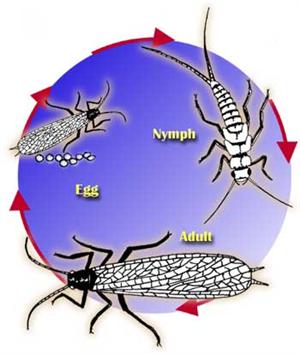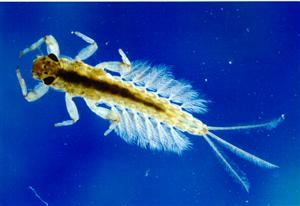Aquatic Organisms: Invertebrates
Invertebrates include all animals without a backbone. Invertebrates are far more diverse and abundant than vertebrates, and many groups of invertebrates are found in aquatic systems. Invertebrates living on or in aquatic sediments are termed benthic invertebrates. Benthic invertebrate communities—including measurements of population abundance and diversity—are often used as indicators of aquatic ecosystem health. Some of the more common benthic invertebrates are described below.
Worms are an informal collection of three major groups, including flatworms (Platyhelminthes), roundworms (nematodes), and segmented worms (annelids). Flatworms include a major group that is free-living and often predatory (Turbellaria), and two major groups, Trematoda (flukes) and Cestoda (tapeworms), that have adult stages that are entirely parasitic, although their intermediate stages may be aquatic. Some flukes and tapeworms are important parasites of humans, often causing serious illnesses.
Molluscs include the familiar groups of snails (gastropods) and bivalves (clams and mussels). A hard shell encloses, wholly or in part, the bodies of most molluscs. Snails feed by scraping biofilm from surfaces, collecting organic matter deposited in the sediment, consuming macrophytes, or feeding on decaying animals. Bivalves have gills, which they use both for breathing and for collecting small particles from the water.
Insects are the most diverse group of animals on earth. Most insects are terrestrial, while some have life stages that are aquatic (e.g., dragonflies and mosquitoes). A few insects are entirely aquatic (e.g., aquatic beetles). While most aquatic insects live on or near the bottom of waterbodies, though some (such as the larvae of the phantom midge Chaoborus) can swim into the water column. Most aquatic insects have gills and need water with dissolved oxygen while others, such as mosquito larvae, breathe through the surface film of still waters. Insects may be herbivores, carnivores, or detritivores. Stream and river insects are crucial in the processing of organic matter. Some scrape biofilm, others shred larger leaves into smaller particles, while still others filter or collect these smaller particles. This chain of processing reduces large organic matter to successively smaller and smaller particles.
Zooplankton are aquatic animals that cannot swim against water currents, typically because they are too small to do so. However, many zooplankton can swim significant distances in fairly still waters. Because they cannot swim against currents, they are more important in lakes than in running water, as running water usually carries them downstream faster than they can reproduce. However, they can be abundant in large slow flowing rivers. Zooplankton are heterotrophic and are significant sources of energy and nutrients to carnivorous invertebrates and some vertebrates.










